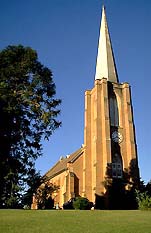
|
| St Johns Church
|
Camden (including Camden Park, Cobbity, Narellan,
Kirkham, Catherine Fields)
Historic township now part of southwestern Sydney's
suburban sprawl
Camden is located by the Nepean River 62 km south-west of
Sydney and 68 m above sea-level.
Before European occupation it was much used as a hunting
area by the Gundungurra Aborigines, who called it 'Benkennie',
meaning dry land. As the whites took over the land, the game
which fed the Aborigines began to disappear and,
subsequently, cattle were attacked. In 1816, Governor
Macquarie sent troops to kill or imprison the Aborigines
although a corroboree attended by around 400 tribespeople
was recorded in the area in the 1820s. In subsequent years
the Gundungurra seem to have virtually disappeared though
records are very poor.
Much of the initial European focus on this area related
to the fact that seven of the eight cows on the government
farm at Farm Cove had strayed just four months after the
First Fleet's arrival. They were not seen again until 1795
when they were spotted west of the Nepean River.
Confirmation of the sighting led to an expedition which
included Governor Hunter and explorer George Bass in 1795.
They found the herd had increased to over 40 and were
grazing by the river where the town of Camden now stands.
Macquarie returned the following year, climbing Mt Hunter
and naming the district Cowpasture Plains. David Collins
described the area as: "remarkably pleasant to the eye;
every where the foot trod on thick and luxuriant grass; the
trees were thinly scattered...several beautiful flats
presented large ponds, covered with ducks and the black
swan, the margins of which were fringed with shrubs of the
most delightful tints, and the ground rose from these levels
into hills of easy ascent."
Explorer Francis Barellier visited the area in 1802 and
Governor King in 1803. His wife became the first white woman
to cross the Nepean. A hut was established near the eastern
side of what is now the Cowpasture Bridge near present-day
Camden in 1803 or 1804. It was used to store salted meat and
later housed the area's first constables.
In an attempt to exert control over what had become
several thousand wild cattle, Governor Macquarie established
three cattle stations on the Cowpastures in 1813. The main
station was at Cawdor, 3 km south of present-day Camden.
With the cattle either moved, slaughtered or missing all
three were closed in 1826.
At the beginning of the 19th century the cattle provoked
the curiosity of the colony's gentry who began to visit the
area. John Macarthur and Walter Davidson both selected land
west of the Nepean.
Macarthur named his property Camden Park Estate in honour
of Lord Camden, then the colonial secretary. This tribute
comes as no surprise when it is considered that it was Lord
Camden who ordered Governor King to grant Macarthur the 2000
hectares.
After being sent to England to face charges relating to a
duel with his commanding officer Macarthur was allowed to
choose some merinos from the royal stud at Kew in order to
convert the colony into a major wool-producing domain to
supplant the dominance of the Spanish in that market..
The achievement of this goal probably owes more to
Macarthur, his wife, nephew and two sons than to any other
individuals and their contribution was realised at Camden
Estate. Hence it is a property of great historic
significance. Macarthur died in 1834. His wife continued to
run what had become the most advanced wool-producing sheep
station and the most highly developed mixed farm in the
country.
The Macarthurs were also the first to introduce
mechanical irrigation, the first to grow tobacco plants and
the first to produce Australian wine in quantity and
quality.
During his exile from Australia (1809-1817) Macarthur
toured the vineyards of France where he accumulated vines
and expertise. He established a commercial vineyard in 1820.
In 1829 Camden Estate yielded 90 000 litres. Macarthur made
Australia's first brandy at Camden Park in 1832. The family
sent thousands of vines to the Barossa Valley which helped
to start the wine industry in South Australia. Camden Park
won a gold medal at the Paris Exhibition of 1861.
Governor Macquarie began issuing the land around the
Cowpastures in large grants from 1810. John Oxley received
two off these properties, naming them Kirkham and Elderslie.
These large estates became semi-autonomous villages.
The Cowpastures land was made available to settlers from
1820. In 1830 the swelling ranks of local residents wrote to
the governor suggesting a townsite near the Cowpastures
bridge, which had been designed by a convict named
Wainwright and erected as a toll bridge in 1826 (the current
span is the fourth) . The surveyor-general picked a site on
the western side of the bridge and the first 100 blocks were
sold in 1840. The first hotel, the Camden Inn, was built by
1842. The court and other public functions were transferred
from the earlier settlement at Cawdor in 1841 signalling the
decline of that centre relative to Camden.
The town's first public school opened in 1851 (the
Macarthurs had earlier established a private school on their
estate and the first church school opened in 1838). The
town's population increased only marginally from 342 in 1851
to 505 in 1881. The railway arrived in 1882 and a municipal
council was established in 1889.
Camden was envisaged as a satellite city of Sydney in the
Three Cities Structure Plan of the 1970s, providing housing,
work and proximity for those who had to commute.
Subsequently the population increased from 3427 in 1966 to
22 473 in 1991.
Things to see:
![[Top of page]](smlArrow.gif)
Visitor's Centre
The Camden Visitors' Centre is located at Curry Reserve,
just north-east of the Cowpasture Bridge over the Nepean.
The centre is housed in a worker's cottage which dates from
the 1890s. It is one of a row of small houses which once
lined the road into Camden. They have a range of pamphlets
outlining walking and driving tours and local picnic spots.
There is a sensory garden adjacent.
Historic Walk
Wander along Argyle St to the first crossroad, Elizabeth St.
The Merino Tavern on the corner was built on the site of the
town's first hotel, the Camden Inn (1840-42).
Turn right into Elizabeth St and continue along to
Mitchell St. At number one is Nepean House, a lovely old
building dating back to c.1857 with decorative carved wooden
bargeboards on the gables.
Most of Camden's historical buildings are located in John
St. They form an impressive streetscape sweeping up to St
John's Church on the hillside at the end of the road.
To the left is St Paul's Catholic Church, a Gothic
Revival structure of brick with stone dressings built on
land selected and donated for that purpose by James and
William Macarthur. The foundation stone was laid in 1859.
On the right are a group of old brick buildings including
the 1857 courthouse (no. 31) and, next door, the 1878 police
station and residence. Both were built on land that was
provided by the Macarthurs who also donated 100 pounds
towards costs. The chief constable's house and a wooden
lock-up initially occupied the site from 1841.
The two-storey brick cottage 'Macaria' (no. 37) is an
outstanding example of Gothic Revival architecture. Of note
are the stone trim, high chimneys, gabled windows and wooden
fretwork on the verandahs. It was built in the late 1840s
for Henry Thompson who built the first flour mill in town
(water-driven) at the corner of Argyle and Edward Sts. He
established a steam-driven mill in the late 1850s. Macaria
now serves as the council chambers.
Out the front is the Silver Ore Memorial Wheel which
commemorates the town's association with the silver mines of
Yerranderie. In the first quarter of the century the ore was
carted to the Camden railhead by horse-drawn wagons. This
wheel was taken from a 14-horse wagon.
Next door is Camden Cottage (c.1830), a small Georgian
residence, thought to be the first built in Camden.
On the corner of John St and Argyle St is the Victorian
Classical Revival CBC Bank building which opened in 1878.
The intricate wrought-iron work on the balconies is
original, as are the medallions of Queen Victoria in the
gates.
At 40 John St is the public library and behind it is the
Camden Historical Museum, located in what was once the
School of Arts (1866). The first meeting of the Camden
Municipal Council was held here in 1889. The museum is open
Thursday, Friday, Saturday and Sunday 11.00 a.m. - 4.00
p.m., tel: (02) 4655 9210. It contains clothes, photographs,
household implements, uniforms, musical instruments,
booklets, maps, furniture, coins, guns and badges. There is
a small entry fee. If you want more detailed information
check out the Historical Society's webpage at
http://www/zipworld.com.au/~scrob/historical.html.
Continue along John St and, on the left, between 70 and
80, are a series of wooden and brick cottages which convey
some sense of how the town would have looked in the late
19th century. Over the road, at number 75, is a substantial
brick residence built c.1860 by the Macarthurs for one of
their overseers, a Mr Druitt. The verandahs sport some
impressive cast-iron columns and balustrades.
St John's Church
Opposite, on the corner of Broughton St and Menangle Rd, is
St John's Church, built on elevated land chosen by John
Macarthur and donated for the purpose by the Macarthur
family who also provided the ironbark from which the ceiling
is constructed and contributed significantly to the overall
cost. This outstanding example of Gothic Revival
architecture is made of 386 000 locally-made red sandstock
bricks. A number of architects appear to have had a hand in
its design, including Mortimer Lewis and Edmund Blacket. The
structure is dominated by a large tower topped by an
enormous needle spire. As a result the church reaches
dramatically skywards. Dominating the cityscape it is
visible from miles around. The effect is further dramatised
at night when the spire is floodlit. There is a a
stone-flagged floor, some beautiful Gothic stone tracery in
the windows and an unusual ceiling. The foundation stone was
laid in 1840 though shortages of funds meant the church was
not completed and consecrated until 1849. The clock was
added in 1897. The wooded and landscaped grounds are
extensive and picturesque. Many early settlers are buried in
the cemetery which has a fine entrance gate. The rectory was
added in 1859, again on land donated by the Macarthurs.
Macarthur Park
Opposite the rectory, at the corner of Menangle Rd and Park
St, is Macarthur Park. The town's finest and most historic
reserve, it has beautiful gardens, sheltered picnic tables
and amenities. The rotunda was erected in 1913 as a memorial
to Elizabeth Macarthur-Onslow, the granddaughter of John
Macarthur. It was she who donated these 67 acres to the
people of Camden in 1905 on condition that they be used for
parkland, that no entry fee be charged, that no business be
conducted on the land and that the timber be preserved. Some
of the ironbarks are thought to be 600 years old. The
gardens have won numerous awards.
Camden Rotary Club Mural
A little further along Menangle Rd is the hospital (1902)
and just beyond it is the Camden Rotary Club Mural, a
memorial to the local European pioneers. It is mounted on
200 tonnes of stone taken from an old church in Burragorang
Valley before it was flooded.
The old mine poppet head wheel in Little St is from the
Oakdale mine, restored by a local resident and intended as a
memorial to an industry which is still important to the
local economy.
Camden Park House
South of here is Camden Park House. This gracious, imposing
and beautiful country mansion was commissioned by John
Macarthur and designed by John Verge (1832-35). One of his
finest works it is still occupied by members of the
Macarthur family. The two-storey house is built of stuccoed
sandstock bricks and flanked by single-storey pavilions. It
possesses a grand colonnade verandah and sandstone portico.
Inside are a plenitude of family heirlooms and colonial
furniture. There is a large brick stable and, on a hill, the
family mausoleum where John and Elizabeth Macarthur are
buried.
The house can be seen during annual open days on the
second-last weekend of September, tel: (02) 4655 8466. The
surrounding 30 ha of garden represent a fine and rare
surviving example of an early 19th century garden, albeit
with later additions and alterations.
The first residence on the site was a simple slab and
bark hut used by Mrs Macarthur during her husband's exile -
the site now being marked by a stone cairn. It was succeeded
by Belgenny Farm House (1821), a humble timber vernacular
cottage which served the couple until Macarthur's death.
This house and the related outbuildings form the oldest
group of farm structures in Australia. It was here that
Australia's wool industry started.
By the 1840s there was a largely autonomous settlement at
Camden Estate of some 800 people. The bell on the brick
cairn was rung to signal time to the employees. An
unfortunate hand was killed in 1935 when he pulled too hard
and the large bell came down on his head.
Amongst the many other buildings there is a blacksmith's
with original bellows and forge, an interesting octagonal
shed and, near the main roadway, a row of workmen's
cottages. Nearby is what remains of the camellia garden
established by William and Elizabeth Macarthur who took a
special interest in the tree. In the remnants of the orchard
is Australia's oldest-surviving apple tree, a Gravenstein
planted in 1837 by William Macarthur along with some English
magnolias. Also on the property is Australia's oldest oak
tree grown from an acorn given to John Macarthur at
Buckingham Palace. A brass plaque on the property marks the
spot where Governor Macquarie and his wife camped in 1810
when they first visited the district. The dovecot was built
in 1820. It is said to have housed pigeons that flew with
messages between here and Macarthur's Parramatta farm. South
of here is the Elizabeth Macarthur Agricultural Institute.
Cawdor
At the end of Argyle St in Camden is a roundabout. The road
opposite Argyle St is Cawdor Rd which heads south through
the village of Cawdor, the earliest and most important
centre of settlement on the Cowpastures until Camden town
was established. A hut was built at Cawdor for the herdsman
guarding the cattle in 1804 and a house for the
superintendent went up in 1819. When the public offices were
transferred to Camden in 1841 the settlement at Cawdor was
closed. Heading along Cawdor Rd, on the right, between
Druitt Lane and Westbrook Rd, are some old farmhouses
established on land leased from the Macarthurs, most notably
Mayfield, Burnham Grove (no.482) and Oldham Hills. Opposite
the Westbrook Rd turnoff is the late 19th century Methodist
Church which replaced an earlier church erected mid-century.
Just past it, at 470, is an ancient slab hut which it has
been speculated may be the original 1804 cattleman's bothy.
The Camden Valley Inn, at the corner of Remembrance Driveway
and Wire Lane, is a lovely English-style country pub and
restaurant with award-winning five-acre gardens.
Cobbity
Another old and rather beautiful village is Cobbity,
originally spelled 'Kobbaddee' or 'Cobbedee', which was
settled in 1812. With its historic buildings, tranquil
atmosphere and pleasant rural setting by the Nepean it makes
for a very pleasant day-trip. To get there turn off Cawdor
Rd just south of Bicentennial Park into Smeathers Lane,
which becomes Werombi Rd. Nearly 4 km from Cawdor Rd
Brownlow Loop Rd branches off to the left. Here you will
find the impressive Brownlow Hill homestead (1829 with
additions in 1834 and 1875) with its stone console table,
marble fireplaces, fine cedar joinery, stone-flagged
verandah and wide French doors. It is beautifully situated
in a sophisticated and remarkably well-preserved landscaped
garden established in the 1830s after contemporary English
fashions. There is an aviary and a sundial lies at the
centre of the parterre. The brick stables are also of
interest.
Cobbitty Winery, tel: (02) 4651 2281, are open seven days
a week and have barbecue and picnic facilities.
Past the school are St Paul's, Heber Chapel and, across
the road, St Paul's Rectory. The excellent sandstone church,
in its picturesque rural setting, was designed in the Gothic
Revival manner by John Verge and John Bibb and consecrated
in 1842. The original box pews remain inside and there is an
historic graveyard. The Georgian chapel dates from 1827 and
was named after Bishop Heber of Calcutta, a noted writer of
hymns. The handsome Gothic rectory (1870) has stone quoins,
dormer windows, carved wooden bargeboards on the gables,
cedar joinery and a steep slate roof.
Wivenhoe
Continue on to Macquarie Grove Rd which heads off to the
right. 2 km south along this road is a private track that
leads to Wivenhoe, a Regency country house built c.1837-38
for MP Charles Cowper by John Verge on land granted by
Governor Macquarie to the Reverend William Cowper in 1812.
The house has a classical portico with sandstone Doric
columns and a flagged verandah with timber columns. There is
some ornate joinery and Art Nouveau additions from the late
19th century. Guided tours of the house are possible by
appointment only, tel: (02) 4655 7483. The stables were
built in 1834 and are enclosed by a high brick-walled stable
yard. Very much in original condition they now house a craft
centre, open from 9.00 a.m. - 4.30 p.m. every day except
Thursday, tel: (02) 4655 6061. There is an Australian native
garden with barbecue areas.
Camden Aerodrome
Camden Aerodrome where you will find vintage aircraft,
gliders, Razorback Skydiving (02-4677 1845) and Balloon
Aloft, who offer balloon tours of the area combined with a
champagne breakfast, tel: 1800 028 568. Just by the entry
road to the airport is Macquarie Grove, built on land
granted to the missionary Rowland Hassall in 1812. The core
of the house dates from somewhere around 1815 with the wings
added later. It is now used in connection with the airport.
The adjacent bridge over the Nepean is a good spot to launch
a canoe.
Kirkham
Down Kirkham Lane isKirkham, originally a land grant from
Governor Macquarie to John Oxley. On the left-hand side of
the road is Oxley's Anchor, thought to have come from one of
Oxley's ships. There is a tributary inscription. In the
paddock behind the anchor lies the grave of the racehorse
Chester who won the Melbourne Cup in 1877. He was owned by
James White, the great-uncle of noted Australian author
Patrick White.
Nearby are the large, two-storey Kirkham Stables. Built
by Oxley in 1816 this is probably Australia's
oldest-surviving stables building. The original horse stalls
are still intact.
Further down the lane is James White's magnificent and
very large three-storey house, Camelot (originally called
Kirkham House) one of the finest contributions to Australian
architecture of Canadian-born J. Horbury Hunt. It was built
in 1888 on the foundations of John Oxley's mill. It is now
privately owned. This dense and complex design features
chimneys, gables and arched bay windows. There is a
beehive-shaped smoke house and an unusual octagonal hen
house. Even the gardener's lodge and stables are of the very
highest architectural quality.
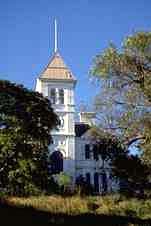
|
| Studley Park house,
Narellan |
Narellan
This township may have been named from William Hovell's
early property Naralling. Hoddle marked out the village in
1827. It was the first townsite in the Camden district,
again on land formerly granted to John Oxley.
On your right before you reach the residential area is
Studley Park Golf Course. There is a large and historic
towered mansion on the property built for W.C. Payne in 1889
at the height of a housing boom. Due to its size and
grandiosity and the cost incurred it came to be known as
Payne's Folly. There is a wealth of iron lacework. The
interior is as extravagant as the exterior with decorative
joinery, elaborate ceilings and stained glass. At the back
is a large block containing the stables and coach house.
At the next set of lights, to your right, is St Thomas'
Anglican Church (1884), a simple brick building in the Early
English style designed by Edmund Blacket and built by his
sons after his death. It is considered typical of Blacket's
rural designs. There is a rather charming church hall
adjacent (1839).
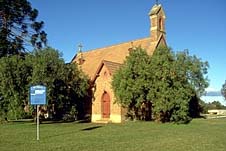
|
| St Thomas' Anglican
Church, Narellan |
The next major road to the left is The Northern Rd.
Nearly 3 km along this route is Oran Park Rd which will take
you to Oran Park Raceway. Opposite the entrance is Denbigh,
built in 1817 and still in its original condition. Thomas
Hassall, who purchased it in 1826, added the stuccoed brick
two-storey section. .
If you continue along The Northern Rd for another 8 km
you will come to Bringelly Rd on your right. Turn off here
and after nearly 2 km Jersey Rd appears to your right. At
Lot 11 you will find the Australian Koi Farm where there are
several million Japanese koi fish on display. The farm has
won prestigious international awards for its breeding. It is
open seven days a week, tel: (02) 4774 8180.
If instead you continue along Camden Valley Way the first
left after The Northern Road takes you into Sharman Close.
At the corner of Sharman Close and Stewart St is the
Struggletown Fine Arts Complex. The old cottage dates back
to the 1840s. The walls are rough-hewn slabs, the floors are
of compressed earth and the slate roof is supported by gum
saplings.The Boyd Gallery building was completed in 1919.
The Camden Aviation Museum is located at 11 Stewart St.
Therein lies a private collection of military aircraft,
tanks, equipment, memorabilia, models and photographs. It is
open Sundays and public holidays or by appointment, tel:
(02) 9529 4169.
Opposite the Sharman Close turnoff is Narellan Road.
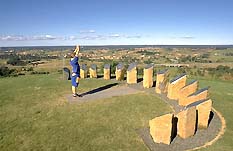
|
| The Sundial at Mt Annan
Botanic Garden |
Mt Annan Botanic Garden
Just over 3 km along this road is the entrance to the
shining glory of the area, Mt Annan Botanic Garden,
Australia's largest botanic garden. Within its 400 ha you
will find 20 km of walking trails, a loop road, two
ornamental lakes with lakeside picnic areas, an education
centre, nursery and arboretum, an abundance of birdlife,
most of Australia's known native plant species and some
introduced species. The flora is featured in a variety of
settings - a terrace garden, a bottlebrush garden, a wattle
garden, a banksia garden and a western garden. There are
also woodland and lakeside plant communities. From the hill
it is possible to see Campbelltown, the Sydney skyline to
the north-east, and, to the south-west, the Menangle
district and the Razorback Range. There are picnic
facilities, bike tracks and bicycles for hire. The entry fee
is currently $5 a car.
Guided walks and mini-bus tours are available for free on
a daily basis depending on staff availability, tel: (02)
4648 2477. Don't miss the human sundial, a sculptural feat
made of basalt columns which allows you to tell the time by
raising your hands in the air (just follow the instructions
on the brass plate).
Just over a kilometre north of Sharman Close along Camden
Valley Way is a side road to the left which leads to
Harrington Park Homestead. This two-storey Georgian country
house was built prior to 1830 on land granted to Captain
William Campbell in 1815. He left the estate to his two
nephews, one of whom, Murdoch Campbell, was shot by
bushranger John Lockhart in 1833.
El Caballo Blanco
2.5 km north of this road along Camden Valley Way is El
Caballo Blanco at Catherine Fields where you can see
performances by Spanish dancing stallions and a miniature
Fallabella horse show. There are also waterslides, train
rides, row boats, car rides, horse-drawn omnibus rides, pony
and trail rides, a small wildlife zoo, an antique carriage
museum, souvenirs, eateries and a craft shop. The complex is
open seven days a week from 10-4.30, tel: (02) 9606 6266.
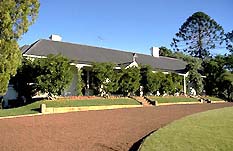
|
| Gledswood Homestead
|
Gledswood
At the northern tip of the El Caballo estate is, to your
right, a road that leads off to the historic property of
Gledswood. The land was granted to James Chisholm in 1829
and the family became pioneers in the wool industry. It has
been transformed into a family-oriented tourist attraction
which offers horse rides, laser clay shooting, skeet
shooting, sheep shearing, sheep-dog mustering, cow milking,
boomerang-throwing lessons, arts and crafts and a tour of
the convict-built stone rubble homestead (c.1830). Some of
the house's rooms have been furnished and decorated in the
Victorian manner. There are multi-paned French windows,
four-panel doors, beautiful gardens and a separate kitchen.
The decorative porches and verandah were added in the 1870s.
A winery has been established in the old coach house which,
it is said, dates back to c.1810. The complex also has a
licensed restaurant as well as barbecue and picnic
facilities, tel: (02) 9606 5111.

Broadwalk
Business Brokers
Broadwalk Business
Brokers specialise in General Businesses for Sale, Caravan Parks for
Sale, Motels for Sale, Management Rights & Resorts for Sale, Farms for
Sale, Hotels for sale,Commercial & Industrial Properties for Sale.
Phone:
1300 136 559
Email:
enquiries@broadwalkbusinessbrokers.com.au
AUSTRALIAN BUSINESSES FOR SALE
COFFS HARBOUR BUSINESS BROKERS
BROADWALK BUSINESS BROKERS
GOLD COAST BUSINESSES FOR SALE
BRISBANE BUSINESSES FOR SALE
SYDNEY BUSINESSES FOR SALE
CARAVAN PARKS FOR SALE
BUSINESSES FOR SALE
MOTELS
FOR SALE
HOTELS
FOR SALE
Disclaimer
We advise prospective purchasers that we take no
responsibility for the accuracy of any information in the business
provided by vendors or their professional advisers and that they should
make their own enquiries as to the accuracy of this information,
including obtaining independent legal and/or accounting advice
Camden